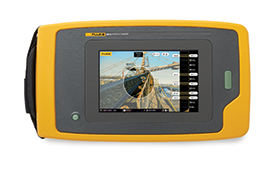

To help users identify and localise ‘mechanical areas of interest’ within short timeframes, Comtest has added a unique new feature to Fluke’s ii910 precision acoustic imagers. The
The update was developed following extensive research involving Fluke customers worldwide. Maintenance specialists and technicians said their crucial focus was identifying issues on the potential failure curve as early as possible.
Looking at various types of conveyor systems, the research showed that non-driven bearings were often the root cause of many mechanical faults. Because these systems were integral to the overall production process, lengthy downtime could significantly impact the factory and cause significant issues along the supply chain. This applied in food and beverage production as much as in the logistics, electronics, automotive, and mining/raw materials sectors.
Never inspected
A line going down is a huge concern, and can cost up to R2,4 million. Despite this, Fluke found that around 59% of conveyor belt systems were never inspected. In comparison, another 11% were checked manually. Fluke’s research showed that human sensing was the least effective way of detecting a problem, followed by contact temperature and thermography. Testing using contact vibration or airborne ultrasound also represented a challenge – with ease of use being a significant issue with the latter. Acoustic imaging offered the most effective method.
Not only did customers say that the ability to localise issues was vital if substantial cost savings were to be achieved, but they also needed a scalable solution that could help those with lengthy conveyor systems, where a significant-size warehouse could operate up to 80 km of conveyor belts. Accessibility was also an issue, for example because of conveyor guards.
Using the Fluke ii910 acoustic imager with MecQ, the process of carrying out non-contact inspection on conveyor systems is simplified considerably, with the unit immediately identifying the locality of a mechanical area of interest through sound pattern comparison. Once the issue is displayed on a screen, the maintenance professional can note it, share it with the team, and address it on the maintenance schedule.
User-selectable frequencies
MecQ brings an extra layer of detection to the ii910; in addition to taking a picture, taking a video, carrying out leak detection with LeakQ, and detecting partial discharge in PDQ mode.
Although the most common frequency for ultrasound instruments is 30 kHz, the ii910 with MecQ now offers user-selectable frequencies from
Members of maintenance teams love the ease of use of the new MecQ facility, with its intuitive interface and seamless integration with existing leak and partial discharge detection tools. They also appreciate the ability to boost efficiency, maximise uptime (by reducing meantime to repair) and lower costs, while ensuring high safety levels through contactless inspection and eliminating hazardous situations. Thanks to MecQ, the ii910 now enables maintenance engineers to locate a problem, annotate a screenshot, share this with the team, and then schedule repairs during planned downtime. Having all these workflow solutions built into a single tool is unique to Fluke. The Firmware 5.0 upgrade has also simplified what could ordinarily be a highly complex and time-consuming inspection and maintenance operation.
Product: https://bit.ly/42d5nAv
| Tel: | +27 10 595 1824 |
| Email: | [email protected] |
| www: | www.comtest.co.za |
| Articles: | More information and articles about Comtest |

© Technews Publishing (Pty) Ltd | All Rights Reserved